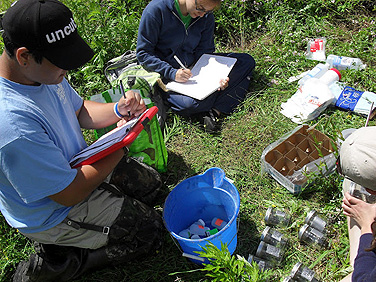News
Are stream-restoration projects working?

Students prepare stream samples in Elton Creek in New York to support future restoration. This summer research project was run by UB’s Ecosystem Restoration through Interdisciplinary Exchange Research (ERIE) program. Photo: COURTESY ERIE PROGRAM
-
 Print
Print -
 Comments
Comments
-

As part of UB’s ERIE Integrative Education and Research Traineeship (IGERT) Stream Restoration Workshop, instructors and attendees evaluate fish numbers and diversity in a local stream. Photo: COURTESY ERIE PROGRAM
The nation’s $1 billion stream-restoration industry needs to do more to ensure that projects are guided by science, according to the co-editor of a new American Geophysical Union (AGU) monograph reviewing the state of the field.
“There needs to be research behind solutions,” Sean J. Bennett, professor in the UB Department of Geography who edited the book with Andrew Simon of Cardno ENTRIX and Janine M. Castro of the U.S. Fish and Wildlife Service.
“Right now, it’s an industry-driven field,” Bennett continues. “Private enterprises and consultants complete projects for clients, relying primarily on experience—on what worked in the past. But you cannot import technology from other locations with different topographies and ecosystems, and expect the same result.”
Stream restoration encompasses a wide range of activities, such as bringing fish and other wildlife back to a river, or replacing lost vegetation on banks to prevent erosion.
Because practice has outpaced research, projects on real waterways often turn out to be experiments themselves, and many fail. People undertake a project without fully understanding which restoration techniques work or how a river will respond to the techniques employed.
The new AGU monograph, “Stream Restoration in Dynamic Fluvial Systems: Scientific Approaches, Analyses and Tools,” provides detailed explanations of best practices grounded in science. Topics covered include using wood in stream restoration, controlling debris at bridges, stabilizing river banks and more. Dozens of researchers contributed to the book.
Bennett’s goal is to bridge the gap between academia and practice. He notes that many companies, grassroots organizations and government agencies are doing valuable work in the field.
However, he believes that researchers and practitioners need to become better partners to ensure that money spent on waterways is not wasted. One widely cited analysis from 2005 estimated that agencies across the United States spent an average of about $1 billion each year on river restoration.
Scientists are still trying to understand what works and what doesn’t work in stream restoration, and industry participation will be key to achieving those objectives, Bennett says. Today, it’s difficult to evaluate the success of restoration projects because private firms are reluctant to share data that may give them an edge over their competitors.
To encourage better communication, Bennett is educating students—who may become practitioners—about the value of research-tested solutions. In June, he will be an instructor in a series of UB workshops on ecosystem restoration.
Bennett also is active in UB’s Ecosystem Restoration through Interdisciplinary Exchange (ERIE) program, which organizes a variety of activities devoted to restoration. ERIE offerings include an Integrative Education and Research Traineeship (IGERT) program for PhD candidates and a summer Research Experiences for Undergraduates (REU) program, both funded by the National Science Foundation.

Reader Comments